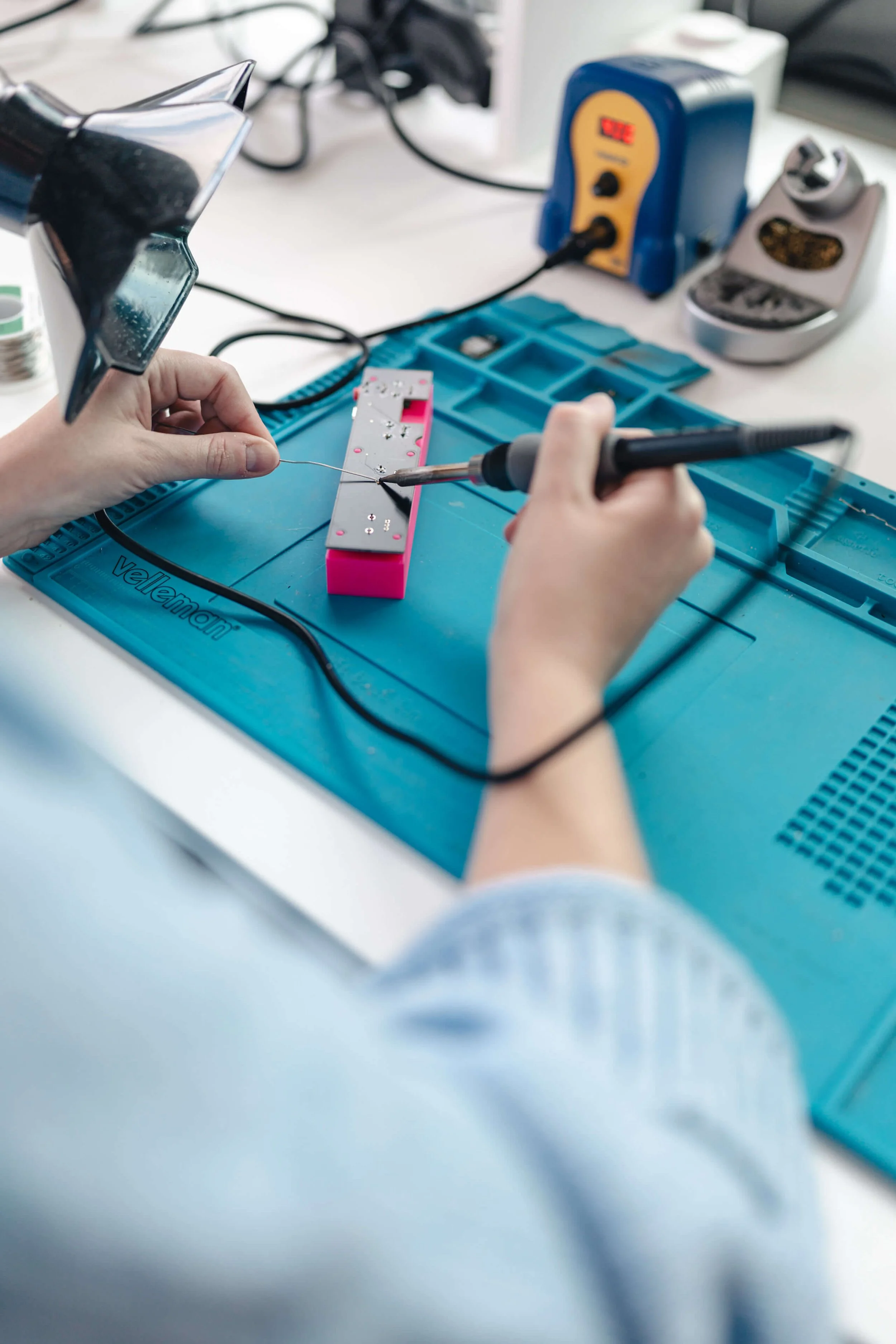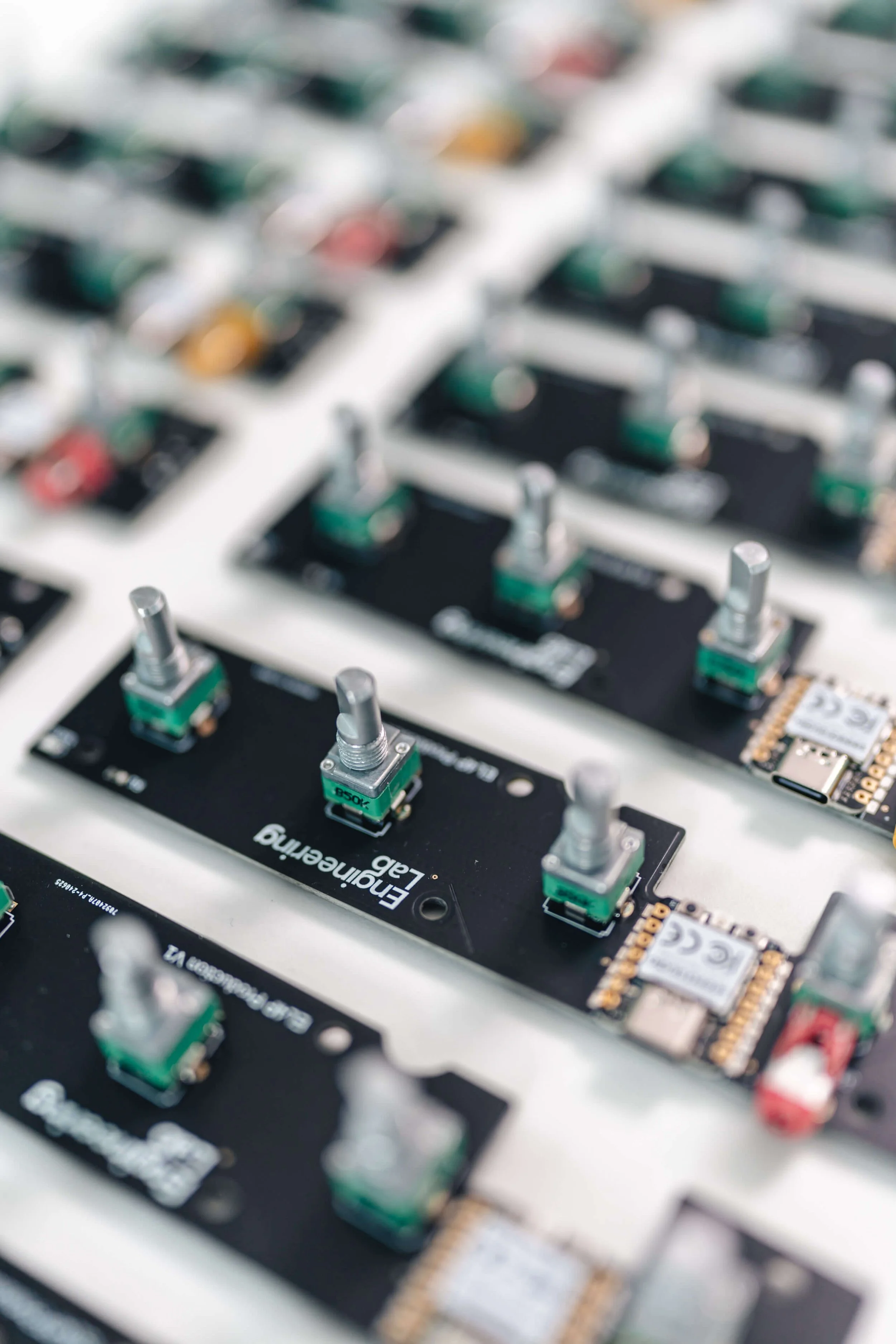MIDI Product Development
Designing MIDI controllers comes with its own set of challenges. Every knob, button, and fader must feel precise, responsive, and intuitive. Balancing electronics, firmware, and physical design requires careful planning to ensure reliability without compromising playability. Understanding these constraints early in the process helps transform initial concepts into high-performance controllers that are both ergonomically refined and functionally excellent.
A recent project by Engineering Lab for AM Components, showing the new MOD POD controller prototype with the top housing removed to reveal the integration of the electronics and the placement of wheels and knobs within the internal design.
MOD POD controller fully assembled prototype, ready to be shipped to AM Components in the United States for testing. At this stage, the prototype body and parts are SLA printed, and the buttons are Silicone-Molded on site.
Determining the Intended Use
At the very beginning of designing a MIDI controller, it is essential to let the purpose drive the form. Every choice, whether it is the placement of a knob, the type of fader, or the layout of switches, should be guided by how the controller will be used. Is it intended for a software DAW, a specific piece of hardware, or to expand existing functionality? Are you the right person to define what is needed, or do you need to conduct research to understand what users actually want from this product? Gaining insights from real-world use cases, observing workflows, and considering the expectations of potential users are crucial steps that should never be overlooked. Thoughtful design decisions at this stage not only prevent unnecessary complexity but also create a more intuitive and satisfying user experience, potentially making the difference between producing one of the most celebrated MIDI controllers of the 21st century or ending up with a batch of poorly functioning products no-one wants to buy.
Purpose-Driven Design
When designing a MIDI controller, it is important to focus on the intended use and workflow rather than forcing a particular mechanical solution. For example, if a jog wheel needs to be operated by the left hand while the right hand is turning another potentiometer, placing those two components too close together could make simultaneous use difficult. Similarly, positioning a power button on the top face near other movable controls might simplify internal electrical connections, but from a user perspective, it could lead to the controller being accidentally turned off during use: an issue that can never be fixed through firmware updates. These are critical design decisions that must be considered early in the product development journey.
There are also more technical approaches to managing internal space and component integration while maintaining a good user experience. For instance, a rotary encoder could be mounted on a modular sub-panel instead of being routed through a thick housing, or a row of buttons could be grouped on a separate PCB to simplify wiring and assembly. Small adjustments like these reduce assembly challenges and ensure every component performs reliably.
At the same time, considering ergonomics and manufacturability from the start can save time and maintain quality. Slight changes to component placement can make soldering and mechanical integration easier while enhancing how the controller feels and responds. In some cases, complex layouts or features may be unavoidable, but carefully thinking through purpose and workflow ensures that every design choice adds real value to the final controller.
Producing small batches in-house before placing large third-party orders allows for thorough quality control, final design adjustments, and extended real-world testing. This approach ensures that any issues are identified and resolved early, reducing risk before committing to full-scale manufacturing.
Freshly assembled PCBs developed for this project. By designing and assembling prototype PCBs in-house, we gain a significant time advantage and ensure that every specified component fits and functions correctly. This approach also gives us full quality control over small-batch manufacturing.
Housing, Component and Material Choices
Choosing the right housing and materials is a key part of designing a MIDI controller. Aluminium housings, for example, provide a premium feel and durability, and while they may cost more than plastic, boutique controllers often allow flexibility in material selection as their pricing is higher than their mass-produced counterparts. There are constraints when designing for aluminium, and it may not always suit every product. Sheet metal and injection-molded plastic are also widely used, and all of these materials can look excellent if designed and manufactured well. It is important to consider not only appearance but also how the materials affect assembly.
Selecting components is a critical part of MIDI controller design. Components need to be reliably sourced not only now but also well into the future as production ramps up. Avoid choosing parts that are cheap simply because they are the last of a stock batch if you plan to produce at volume later. Equally important is understanding the life cycle of each component. For example, some potentiometers are rated for 50,000 cycles, while others have a much lower guaranteed lifespan. Components that are used frequently need higher-rated versions to ensure durability. How these parts interact with the housing is also crucial. It is preferable to design and source components that can be secured with screws or press fits rather than glue, simplifying assembly, ensuring consistent quality, and allowing for easy repair. Similarly, elements such as caps, knobs, feet, or non-slip bases should be designed for longevity, tactile performance, and straightforward installation. Considering these practical factors reduces labor, streamlines production, and helps maintain high quality in the final product.
Prototyping and Testing
Prototyping and testing are critical steps in developing a MIDI controller. A circuit may look correct on paper and behave as expected in simulation, but until it is physically built and tested, there is no guarantee it will function as intended in the real world. Each iteration must be assembled, checked for tolerances, and tested again to ensure all components fit and perform correctly. Even small changes, such as adding a new button or adjusting a knob, require careful verification. Visualising the layout, evaluating ergonomics, and confirming that everything integrates seamlessly within the housing are essential to avoid costly errors and ensure a reliable, high-quality final product.
Once you have a fully functioning prototype, testing becomes an ongoing, iterative process. Each component, interface, and interaction should be evaluated repeatedly to uncover any usability or performance issues. Buttons, knobs, and faders need to be used in real-world scenarios to ensure they feel intuitive and respond consistently. Any change—even minor adjustments to layout, component choice, or firmware, requires re-testing to confirm that everything still fits and works together as intended. This rigorous cycle of testing and refinement is essential for creating a controller that is not only robust and reliable, but also enjoyable to use, preventing expensive revisions later in production.
3D-printed mock-ups of two faceplate designs for a new MIDI controller for AM Components, allowing the team to tangibly evaluate the spacing and ergonomics of the buttons, wheels, and their placement within the housing.
The first AM Component 3D printed full housings, the first iteration to check placement of parts, integration of the first version of the circuit board and operational user experience.
Software, Firmware, and Updates
When designing a MIDI controller, it is essential to plan not only the hardware but also the software and firmware ecosystem. This includes selecting the software environment based on the MIDI requirements, managing firmware versions, and defining a clear process for users to update their controllers. Consider how updates will be delivered and applied: via USB, with a dedicated button or action to trigger bootloader mode, over Wi-Fi, or through other methods. Providing a reliable and accessible update mechanism ensures that the controller can remain compatible with evolving systems, integrate with new software and hardware, and stay relevant as technology changes. Thoughtful planning in this area prevents obsolescence and enhances the user experience by keeping the controller up to date with the latest features and improvements.
Two fully finished prototypes, built and finished to a high standard and ready to ship to the customer. These pre-production units are fully functional and prepared for testing, with software still evolving as the complete system is refined for full-scale production.
Post-Production and Launch
Once your first batch of MIDI controllers is manufactured, whether in-house or via a third party, the product is nearly in your hands, but preparation does not end there. It is crucial to plan for sales, distribution, and marketing well in advance. Do you have a pre-release sale list? A website and social media presence? Are you generating hype around your device, or planning to showcase it at major events such as ADE, SUPER-BOOTH or NAMM? These considerations, and many more, are essential for a successful launch and should be integrated into the product journey from the very beginning. Sales and distribution are just as important as the creation of the product itself. By addressing them early, you maximise the impact of your launch and ensure that your hard work reaches the audience it deserves.
Testing our very own EL4P in a DJ setup. This is also an ideal time to capture product photos in preparation for pre-launch and official launch.
A sneak peek at the new Engineering Lab EL4R during testing at the DJ booth, adding an external twist to the Pioneer setup.
Final Thoughts
Designing and manufacturing a MIDI controller, or any precision product, requires careful planning at every stage. From material and housing choices, to ergonomics, assembly, software, and firmware updates, each decision impacts usability, manufacturability, and long-term relevance. Early prototyping, testing, and thoughtful design can prevent costly mistakes, streamline production, and ensure a high-quality final product. Considering the full product journey, including post-production, sales, and distribution, is just as important as the technical design itself. By addressing these factors from the start, you can create controllers that are not only functional and reliable but also engaging and future-proof.
Have a project in mind? We’d love to hear about it. Get in touch or book a free call to explore how we can support you at any stage of your product development journey.








